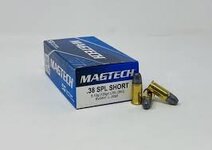Gold Supporter
Silver Lifetime
Bronze Lifetime
- Messages
- 1,453
- Reactions
- 2,739
Good question.That doesn't sound like fun. Did you try pushing it out from muzzle end?
Years ago (before my Rossi 92 squib) I had a squib in an old S&W 4" revolver. Of course the only option for a revolver (other than removing the barrel - which was beyond my skill level) is to push from the muzzle end. Tried that and projectile only moved a little, then just locked-up and wouldn't budge.
Took the revolver to a gunsmith for repair. He showed me the projectile. It was (originally) a TMJ flat point. The nose was smashed flatter and much wider (from my attempt to push it out). He said that - although it is possible to remove a squib from muzzle to chamber - you're fighting the rifling, widening the nose which also makes the projectile jam tighter into the barrel, etc. He recommended that, if possible, squibs be removed from the chamber, pushing the projectile out the muzzle .
I have a "friend" (cough, cough) who reloads and has had a "couple" of squibs over the years. He agrees. If possible, disassemble and remove the squib from chamber to muzzle.
Just my experience.
TWYLALTR
Cheers.











